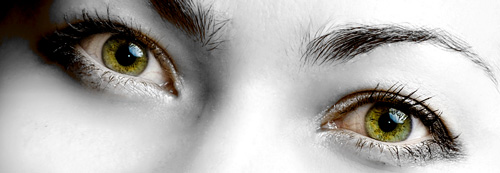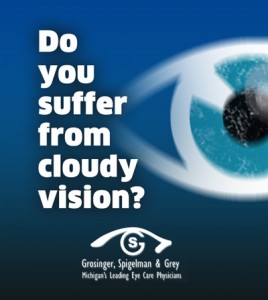 An individual’s lifestyle can sometimes determine whether we contract certain illnesses as we mature. For those entering their forties, cataracts and other types of vision loss can become a concern. Other vision related maladies such as glaucoma, macular degeneration, and diabetic retinopathy can begin to affect our sight as we age; but there are steps you can take to help prevent vision loss and cataracts. [Read more…] about Promoting Good Health and Preventing Cataract Development
An individual’s lifestyle can sometimes determine whether we contract certain illnesses as we mature. For those entering their forties, cataracts and other types of vision loss can become a concern. Other vision related maladies such as glaucoma, macular degeneration, and diabetic retinopathy can begin to affect our sight as we age; but there are steps you can take to help prevent vision loss and cataracts. [Read more…] about Promoting Good Health and Preventing Cataract Development
Carrot Night-Vision Myth Debunked by Historians?

While they may promote eye health in the form of vitamin A, the fact that people believe eating carrots actually improves your eye sight at night is a total sham, and historians believe they have finally found out where this myth all started. Historians at Smithsonian Magazine have found that during the times of World War 2, propaganda campaigns were seen all over claiming that carrots actually improved your night-vision. This in turn seems to be the root for what moms would eventually tell their kids to get them to eat their vegetables at the dinner table.
While they may not help you win your way out of a midnight dog fight, carrots do in fact pack a lot of vitamin A, which promotes good eye health. The fact that the truth had been stretched so thin goes to show how that kind of information spread in those days. The campaign was so successful that in fact pilots who were war heroes, having shot down multiple enemy planes, claimed that their success was due to their over-the-top appetite for the bright orange root vegetables.
Playing perfectly in line with the placebo effect, the pilots would have gone the majority of their lives believing this farfetched tale of vegetable enhancement. Nevertheless, they went into battle believing they had the upper hand, which in turn worked in their favor. Mothers everywhere would use this perfect leverage to get their kids to finish their vegetables whenever they were served. They might not have night vision right now, but they’ll surely have better vision.
It’s never too late to repair or start preserving your eyesight, call Eye Michigan (Grosinger, Spigelman & Grey) for more information.
EDIT: We have recently been informed that carrots DO in fact help you see better at night, through the help of a carrot historian. For more information, please read the comments under the Smithsonian article. Thank you.
LASIK is the key to regaining perfect vision
 We all know by now that LASIK surgery is a reasonable alternative for people wanting to ditch their glasses and contact lenses. The surgery alters the cornea of the patient, allowing them to better focus on objects, thus, reversing years of vision damage. While this surgery is available from a variety of eye professionals, it’s important to heal properly, so that you can recover quickly and efficiently. For a successful surgery, adhere to the following recovery tips.
We all know by now that LASIK surgery is a reasonable alternative for people wanting to ditch their glasses and contact lenses. The surgery alters the cornea of the patient, allowing them to better focus on objects, thus, reversing years of vision damage. While this surgery is available from a variety of eye professionals, it’s important to heal properly, so that you can recover quickly and efficiently. For a successful surgery, adhere to the following recovery tips.
Slow and steady wins the race
Don’t be in such a rush to get back to your normal life. When planning the surgery, be sure that you plan in a way that allows you to slowly ease back into things. Take some extra time off from work if necessary, or plan the surgery leading into an extended weekend. Make sure that you take a grocery trip prior to the surgery, so that you can spend some time indoors without worrying about necessities.
Hop in the tub
While most people are used to taking showers, you run a greater risk of irritating your eyes in the shower than you do in the tub. In the bath tub, you won’t have to worry about water splashing you in the face. When taking your bath, be extra careful to avoid getting shampoos, face washes and soaps into your eyes, as they can become particularly irritating following a surgery.
Follow up with your eye doctor
LASIK surgery has incredibly high success rates, but you should always let your doctor know if anything feels out of the ordinary. Plan to schedule a follow-up visit after the surgery so that you can address any problems, or make sure that you are properly healing.
Eye Michigan – Refractive Lens Exchange – Grosinger, Spigelman & Grey
 Refractive Lens Exchange is a type of surgery that takes the lens out of your eye and exchanges it with a synthetic lens to help sharpen your vision. It is typically performed on people with conditions like hyperopia or presbyopia, which develops due to old age. If you happen to have both, RLE is your only option. If an individual only has one of these, there are options like LASIK, PRK, and phakic IOL. Another name for RLE is clear lens extraction, and it is the most sufficient of all these surgeries for these particular eye conditions.
Refractive Lens Exchange is a type of surgery that takes the lens out of your eye and exchanges it with a synthetic lens to help sharpen your vision. It is typically performed on people with conditions like hyperopia or presbyopia, which develops due to old age. If you happen to have both, RLE is your only option. If an individual only has one of these, there are options like LASIK, PRK, and phakic IOL. Another name for RLE is clear lens extraction, and it is the most sufficient of all these surgeries for these particular eye conditions.
The clear lens extraction procedure is fairly quick. Each eye takes around twenty minutes, each eye done seven days apart. The eye receives drops containing anesthetics to avoid pain, and then the lenses are swiped. It takes about a week for a patient to recover and to be able to resume daily activities. The result of the surgery is clear vision, and the intraocular lens (IOL), which is the synthetic lens used to replace the natural one, is meant to last the rest of your life. Once the surgery is complete, the patient’s vision is typically fixed permanently.
The cost of refractive lens exchange is on average $4000 per eye. Since the results are effective, the surgery is worth it. During the week of recovery, one may experience blurred vision and glare, but these problems go away quickly. For patients with farsightedness and presbyopia, this procedure should be heavily considered because it is the best and most practical surgery for these conditions.
LenSx cataract surgery might be just what your looking for.
 You’re thinking about your options when it comes to cataract surgery, and you’re asking yourself what exactly is LenSx? Can I trust a computer into shooting a laser into my eyes to supposedly fix them? It would make sense to be hesitant when it comes to something, especially if you’re someone older, but believe you me, LenSx is the safest option when it comes to Cataract surgery in this day and age, and we’re about to explain to you why.
You’re thinking about your options when it comes to cataract surgery, and you’re asking yourself what exactly is LenSx? Can I trust a computer into shooting a laser into my eyes to supposedly fix them? It would make sense to be hesitant when it comes to something, especially if you’re someone older, but believe you me, LenSx is the safest option when it comes to Cataract surgery in this day and age, and we’re about to explain to you why.
Traditionally done manually with a blade, cataract surgery has since had a technological overhaul when it comes to the equipment used in replacing someone’s natural lens. The problem with the old method was that even though the surgeons meant well, they couldn’t give each and every eye the precise attention they deserved. Every eye is different in terms of shape, and you can’t calibrate your hand and a scalpel to that.
With lenSx, you get a customized procedure that is tailored to exact specifications that are given the O.K. by your doctor, so you know you’re in good “hands”. Another upside to having the LenSx procedure over anything else is the amount of time it takes. Since the introduction of laser cataract surgery and LenSx surgery, the total procedure time has been cut down to a fraction to what it used to be. Patients have been noted as having better vision in as little as 6-8 hours after their surgery.
If you suffer from cataracts and cloudiness in the eyes, please take the time and do your research on cataract and LenSx surgery. It isn’t the most wide-spread procedure just yet, and it’s not available everywhere so if you have the option of going with LenSx, I would highly recommend it. Grosinger, Spigelman & Grey were the first doctors in Southeast Michigan to offer LenSx, so be sure to call today or visit our website for more information on the breakthrough procedure.
Do you suffer from Cataracts? Could you benefit from Cataract Surgery?
 Cataracts are normally described as the clouds that people get in their eyes when they get older. In the following summary we’ll discuss precisely what a cataract is and what happens to one’s eye when cataracts form in the eye. This should provide you with a “clearer” understanding of what more than 20 million Americans deal with every year.
Cataracts are normally described as the clouds that people get in their eyes when they get older. In the following summary we’ll discuss precisely what a cataract is and what happens to one’s eye when cataracts form in the eye. This should provide you with a “clearer” understanding of what more than 20 million Americans deal with every year.
The eye contains proteins in its lens that helps in allowing you to see. When someone has a cataract, those said proteins are aging and distorting, causing your vision to become blurry. The reason for this is because the blotches of protein are blocking out necessary light needed by the retina, or inner-tissue of the eye, to properly process an image. What happens during surgery is the cloudy lens is removed and replaced with a new, synthetic lens, which allows you to see clearly again.
The most common cause of cataracts is old age, and unfortunately they are inevitable when it comes to that. More than 20 million people in America are suffering from cataracts, with as many as 3 million people getting cataract surgeries yearly. There is an absolute chance that by the time you reach 70 or 80 years old that you will have developed cataracts. With an average cost of about $3, 279 dollars per procedure, it’s important that you find a surgeon that you feel most comfortable with. Grosinger, Spigelman, and Grey have a combined 25 + years’ worth of experience in the field of everything Cataracts and LASIK eye surgeries, so no matter what you issue may be, no matter how young or old you are, you’ll be in good hands with Grosinger, Spigelman and Grey.
